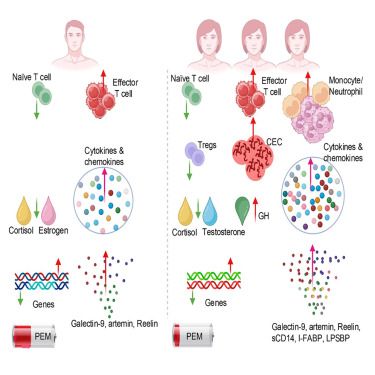
Online now: Nonsense-mediated mRNA decay inhibits TRAF6-dependent anti-tumor immunity in colorectal cancer
24.11.2025 20:19 — 👍 1 🔁 0 💬 0 📌 0@cp-cellrepmed.bsky.social

Online now: Nonsense-mediated mRNA decay inhibits TRAF6-dependent anti-tumor immunity in colorectal cancer
24.11.2025 20:19 — 👍 1 🔁 0 💬 0 📌 0
Online now: Ngn2 and Isl1-mediated astrocyte-to-neuron conversion in vivo promotes functional recovery after spinal cord injury
24.11.2025 13:27 — 👍 0 🔁 0 💬 0 📌 0
Online now: Precision prediction of venetoclax-azacitidine treatment efficacy in acute myeloid leukemia via integrative drug screening and machine learning
23.11.2025 20:19 — 👍 0 🔁 0 💬 0 📌 0
Online now: Unlocking the tumor microenvironment: Innovative strategies for cancer therapy and translational insights
23.11.2025 13:27 — 👍 1 🔁 0 💬 0 📌 0Online now: Voices: Future directions in targeting the tumor microenvironment
22.11.2025 20:19 — 👍 0 🔁 0 💬 0 📌 0
Online now: From bench to body: In vivo CAR engineering in the clinic
21.11.2025 20:19 — 👍 1 🔁 0 💬 0 📌 0
Online now: From visualization to prediction: Dissecting metabolic heterogeneity with DDRTree
21.11.2025 13:27 — 👍 1 🔁 0 💬 0 📌 0
Online now: System analysis links SMARCD3 regulons to growth signaling and MEK inhibitor response in everolimus-resistant ER+ breast cancer cells
20.11.2025 20:19 — 👍 2 🔁 0 💬 0 📌 0
Online now: A prognostic index integrating deep learning baseline PET/CT biomarkers and multi-omics profiling in diffuse large B cell lymphoma
20.11.2025 13:27 — 👍 0 🔁 0 💬 0 📌 0
Taking programmed cell death from mechanisms to interventions
Together with our partners at Zhejiang University, Liangzhu Laboratory, we're thrilled to announce the Cell Symposium: Taking programmed cell death from mechanisms to interventions, taking place in Hangzhou, China, October 22–24, 2026
http://dlvr.it/TPMsG2
#CSCellDeath26

Online now: Virus envelope glycoprotein targeting bispecific T cell engager protects mice from lethal severe fever with thrombocytopenia virus infection
19.11.2025 20:20 — 👍 0 🔁 0 💬 0 📌 0
A gardener removes weeds among flowers—just like therapies targeting the tumour microenvironment can eliminate cancer cells while sparing healthy ones. Dive into our special issue for expert reviews on immune cell targeting in cancer! Artwork by Justine Reimand. www.cell.com/issue/S2666-...
19.11.2025 15:01 — 👍 1 🔁 0 💬 0 📌 1
Online now: Maternal diabetes programs sexually dimorphic early-onset cardiovascular dysfunction in metabolically healthy offspring
19.11.2025 13:27 — 👍 1 🔁 0 💬 0 📌 0
Online now: A combined genomic arrhythmia propensity score delineates cumulative risk
18.11.2025 20:19 — 👍 0 🔁 0 💬 0 📌 0
Online now: Plasma proteomics identifies proteins and pathways associated with incident epilepsy
18.11.2025 13:27 — 👍 0 🔁 0 💬 0 📌 0
Online now: Gene therapy for hemoglobinopathies: Clinical trial results and biology of hematopoietic stem cell and the bone marrow niche
17.11.2025 20:19 — 👍 0 🔁 0 💬 0 📌 0
Online now: A combined genomic arrhythmia propensity score delineates cumulative risk
12.11.2025 20:19 — 👍 1 🔁 1 💬 0 📌 1
Online now: Maternal diabetes programs sexually dimorphic early-onset cardiovascular dysfunction in metabolically healthy offspring
12.11.2025 13:27 — 👍 1 🔁 0 💬 0 📌 0
Online now: The tumor microenvironment of 14,837 breast cancers is associated with clinical outcome independently of genomic subtypes
11.11.2025 20:19 — 👍 10 🔁 8 💬 0 📌 1
Online now: Glucocorticoid-induced changes of the gut microbiota and metabolic markers in healthy young men: Outcome of a randomized controlled trial
11.11.2025 13:27 — 👍 0 🔁 0 💬 0 📌 0
Online now: Microbiome preterm birth DREAM challenge: Crowdsourcing machine learning approaches to advance preterm birth research
10.11.2025 20:19 — 👍 0 🔁 0 💬 0 📌 0
Online now: Non-orthosteric inhibition of enolase 1 impedes growth of triple-negative breast cancer
10.11.2025 13:27 — 👍 0 🔁 1 💬 0 📌 0
Online now: Integrated immune, hormonal, and transcriptomic profiling reveals sex-specific dysregulation in long COVID patients with ME/CFS
09.11.2025 20:19 — 👍 2 🔁 2 💬 0 📌 0
Online now: Therapeutic stress triggers tumor STAT1 acetylation to disarm immunotherapy
09.11.2025 13:27 — 👍 0 🔁 0 💬 0 📌 0
Online now: Aqueous humor biomarkers in ocular oncology: Insights and advances
08.11.2025 20:19 — 👍 0 🔁 0 💬 0 📌 0
Online now: Developing a therapeutic elastase that stimulates anti-tumor immunity by selectively killing cancer cells
08.11.2025 13:27 — 👍 0 🔁 0 💬 0 📌 0
Online now: Fluorinated prodrug-engineered nano-remodeler relieves tumor hypoxia for dual-enhanced ferroptosis-immunotherapy
07.11.2025 20:20 — 👍 0 🔁 0 💬 0 📌 0